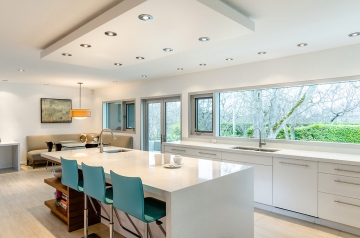Glass
 Published on: 16. 12. 2016 - 9:50
Published on: 16. 12. 2016 - 9:50 The largest area of each window is glass, and therefore it is important to select an appropriate combination of insulated glass that meets the needs of the space.
Besides light transmission, an important feature of insulated (IZO) glass is thermal insulation, which can be achieved by using low-emissive (Low-E) glass and inert gases in between.
Glazing windows with low-emissivity glass should become the standard, because they can save 60-70% of heat that is lost through the glass.
Kajfa standard
Standard glazing on all of our windows is IZO 24 (4+16+4 – that means the double glazing unit consists of a 4 mm pane, a 16 mm spacer and a 4mm pane.) Low-e with heat transfer coefficient Ug = 1.1 W / m2K. The most important function of low-E glass is to reduce the loss of heat in cold months.
Low-E glass on the inside have a thin coating of metal oxide, so that the thermal waves (wavelength of infrared rays) gets rejected from the glass and returned in the direction of the heat source. In this way we keep the heat in the room. A transparent coating on the inside of Low-E glass 4 + 16 + 4 in combination with argon gives you the value of thermal heat transfer Ug = 1.1 W / m2K. Ug factor in normal insulating glass is 2.8 W / m2K which means that on 1 m2 of glass we lose 2.8W of energy in 1 hour if the difference between the outdoor and indoor temperature is 1 ° C. Taking this into account it is obvious that the installation of a
of Low-E glass saves energy, both winter and summer.
In addition, at extra cost, there is the possibility of installing triple glazing Low-E 54 (4+16+4+16+4) whit heat transfer coefficient Ug = 0.5 W / m2K for maximum energy savings and the best sound insulation.




